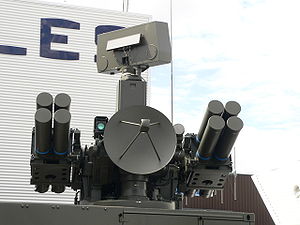| Crotale | |
|---|---|
 Crotale NG at the Paris Air Show, 2007 | |
| Type | Surface-to-air missile system |
| Place of origin | France |
| Service history | |
| Used by | See Operators |
| Wars | Chadian-Libyan conflict South African Border War Russian invasion of Ukraine |
| Production history | |
| Designed | Late 1960s |
| Manufacturer | Thales Group Samsung Group |
| Produced | Early 1970s |
| No. built | 6,600 missiles (R440) |
| Specifications | |
| Mass | R440: 80 kg VT-1: 76kg[1] |
| Length | R440: 2.89 m VT-1: 2.35 m[1] |
| Diameter | R440: 15 cm VT-1: 16.5cm[1] |
| Wingspan | 54 cm |
| Warhead | forward-directed blast warhead (R.440 and R.460) or blast-fragmentation warhead (VT-1) |
| Warhead weight | R440: 15kg VT-1: 13kg[1] |
Detonation mechanism | infrared fuse, converted to RF fuse in later models. |
| Engine | Lens 3 solid-fuel boost-glide (R.440) |
Operational range | VT-1: 11 km Mk3: 15 km[2] |
| Flight ceiling | VT-1: 6,000 m Mk3: 9,000 m |
| Maximum speed | R440: 800 m/s (Mach 2.3) VT-1: 1250 m/s (Mach 3.6) |
Guidance system | Automatic command to line of sight[3] |
Steering system | Canard and tail axis control |
Launch platform | Mobile Launcher, Naval Launch |

The Crotale (English: "Pit Viper" or "Rattlesnake") is a French, all-weather, short-range surface-to-air missile system developed to intercept airborne ranged weapons and aircraft, from cruise or anti-ship missiles to helicopters, UAVs or low-flying high-performance fighter aircraft. It was developed by Thomson CSF Matra (now Thales Group) and consists of a mobile land-based variant as well as various naval ones.
- ^ a b c d "Thales Group VT1 Brochure" (PDF). www.thalesgroup.com.
- ^ "Thales Group Website". www.thalesgroup.com.
- ^ "Crotale (Rattlesnake) / Shahine". www.globalsecurity.org.